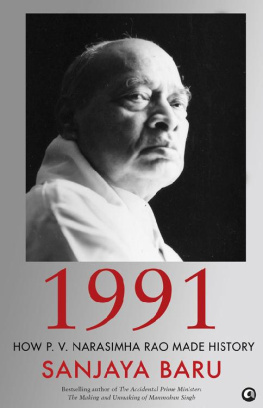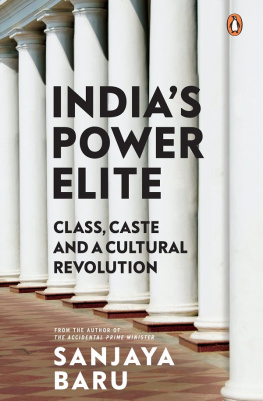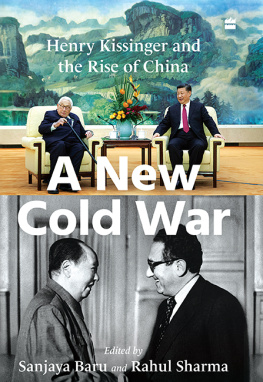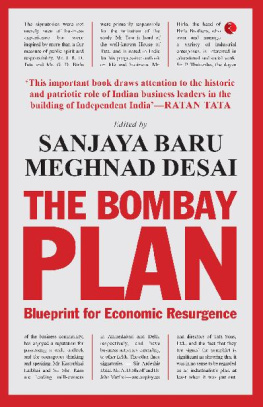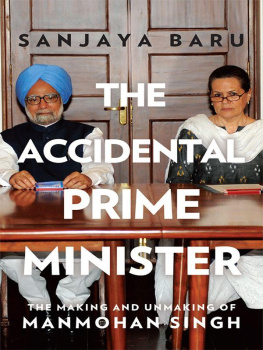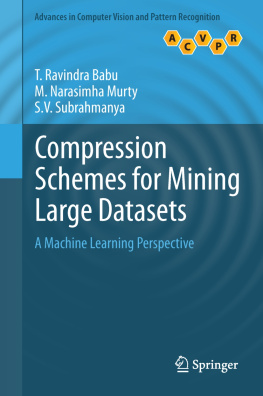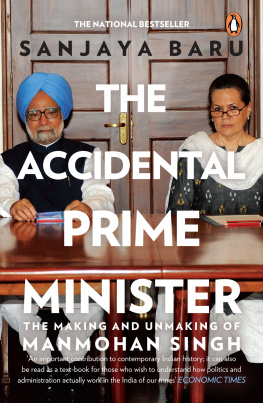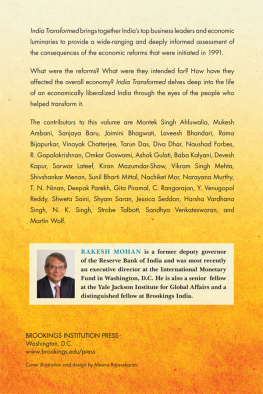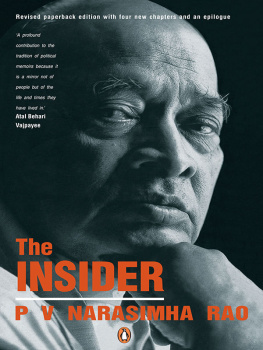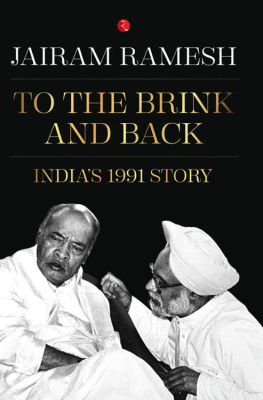Sanjaya Baru - 1991: How P.V. Narasimha Rao Made History
Here you can read online Sanjaya Baru - 1991: How P.V. Narasimha Rao Made History full text of the book (entire story) in english for free. Download pdf and epub, get meaning, cover and reviews about this ebook. year: 2016, publisher: Aleph, genre: Politics. Description of the work, (preface) as well as reviews are available. Best literature library LitArk.com created for fans of good reading and offers a wide selection of genres:
Romance novel
Science fiction
Adventure
Detective
Science
History
Home and family
Prose
Art
Politics
Computer
Non-fiction
Religion
Business
Children
Humor
Choose a favorite category and find really read worthwhile books. Enjoy immersion in the world of imagination, feel the emotions of the characters or learn something new for yourself, make an fascinating discovery.
- Book:1991: How P.V. Narasimha Rao Made History
- Author:
- Publisher:Aleph
- Genre:
- Year:2016
- Rating:3 / 5
- Favourites:Add to favourites
- Your mark:
- 60
- 1
- 2
- 3
- 4
- 5
1991: How P.V. Narasimha Rao Made History: summary, description and annotation
We offer to read an annotation, description, summary or preface (depends on what the author of the book "1991: How P.V. Narasimha Rao Made History" wrote himself). If you haven't found the necessary information about the book — write in the comments, we will try to find it.
1991: How P.V. Narasimha Rao Made History — read online for free the complete book (whole text) full work
Below is the text of the book, divided by pages. System saving the place of the last page read, allows you to conveniently read the book "1991: How P.V. Narasimha Rao Made History" online for free, without having to search again every time where you left off. Put a bookmark, and you can go to the page where you finished reading at any time.
Font size:
Interval:
Bookmark:
ALSO BY SANJAYA BARU
India and the World: Essays on Geoeconomics and Foreign Policy
The Accidental Prime Minister: The Making and Unmaking of Manmohan Singh
The Political Economy of Indian Sugar
Strategic Consequences of Indias Economic Performance

ALEPH BOOK COMPANY
An independent publishing firm
promoted by Rupa Publications India
First published in India in 2016
by Aleph Book Company
7/16 Ansari Road, Daryaganj
New Delhi 110 002
Copyright Sanjaya Baru 2016
All rights reserved.
The views and opinions expressed in this book are the authors own and the facts are as reported by him/her which have been verified to the extent possible, and the publishers are not in any way liable for the same.
While every effort has been made to trace copyright holders and obtain permission, this has not been possible in all cases; any omissions brought to our attention will be remedied in future editions.
No part of this publication may be reproduced, transmitted, or stored in a retrieval system, in any form or by any means, without permission in writing from Aleph Book Company.
ISBN: 978-93-84067-84-7
This book is sold subject to the condition that it shall not, by way of trade or otherwise, be lent, resold, hired out, or otherwise circulated without the publishers prior consent in any form of binding or cover other than that in which it is published.
For my father
B. P. R. Vithal
In celebration of his ninetieth
A t an interaction with students at a university near Delhi, in the winter of 2015, I asked the audience what the year 1991 meant to them. A young man replied without hesitation, and to laughter all around, I was born that year!
I suggested that something else may also have happened that year. Few hazarded a reply.
Earlier that year, addressing a meeting of the Hyderabad Management Association, I had asked my middle-aged audience the same question. Many were quick to reply. It was the year in which the government had introduced new economic policies that opened up the Indian economy.
So who was responsible for that, I asked my Hyderabad audience.
Manmohan Singh! said many, without hesitation.
True, Manmohan Singh was the finance minister who read out the famous budget speech on 24 July 1991one that contained several important policy initiatives and defined a new framework for Indias macroeconomic policy. He became the face of the new turn in Indias economic policies and played a key role as the voice of reform and liberalization even in areas for which he was not directly responsible as minister of finance.
But what was the really historic thing that happened that day, I persisted, for which Manmohan Singh was not directly responsible? Some did murmur decontrol and delicensing. True, the new industrial policy was not part of Singhs famous budget speech. In an initiative characteristic of Prime Minister P. V. Narasimha Raos low-key style, the historic dismantling of the infamous licence-permit raj (also called licence-permit-quota raj) had happened earlier that day when a statement on industrial policy was tabled in Parliament by the minister of state for industry. It was the little known P. J. Kurien, junior minister for industry (made famous more recently by his appearance on television chairing rambunctious sessions of the Rajya Sabha), who had the privilege of tabling the historic statement that liberated Indian industry from years of what amounted to bureaucratic socialism.
So, who was the senior cabinet minister for industry responsible for this major shift in Indias industrial policy? Complete silence. Then someone from the back of the auditorium once again said, Manmohan Singh. Wrong.
Chidambaram! said a few. Kamal Nath, ventured some others.
On that monsoon day in Hyderabad in 2015, no one could recall that a long-time inhabitant of that city, Pamulaparthi Venkata Narasimha Rao, PV as he was always known to the Telugus, was in fact the author of the most radical shift in Indias economic policy since Jawaharlal Nehrus famous Industrial Policy Resolution of 1956. Nehrus resolution had declared that India would strive to establish a socialistic pattern of society. In 1991 PV moved away from that pattern to unleash private enterprise.
It is significant, and relevant to our argument about PVs centrality to the reform process, that as prime minister he not only retained the industries portfolio but also kept the Ministry of Civil Supplies and Public Distribution under his charge. The now famous national rural employment guarantee programme (NREGA) had its initial launch during PVs tenure as prime minister.
This book is not just about PV. It is in fact about 1991. We cannot understand 1991 without understanding the role of the political leadership that made the policy changes of 1991 possible. In that fateful year, India saw new political leaders emerge out of the shadows of the Delhi durbar, who set a different course for the country to follow. Equally responsible for political and economic change were global whirlwinds of various sorts. This book is an account of the politics, the economics and the geopolitics that combined to make 1991 an important year in Indias recent history. But without doubt, the central character was PV. The year made him. He made the year. For India, it was a turning point.

If most of us recognize the major landmarks of global or national history in our lifetime it is not because all of us have experienced them, even been aware at the time that they were landmarks. It is because we accept the consensus that they are landmarks, wrote historian Eric Hobsbawm. For some time now the consensus within public and academic discourse has been that the year 1991 marked a turning point in contemporary Indian history. It was a landmark year.
And yet, the commonplace view is that 1991 was eventful because of an economic crisis that forced India to take a new turn in its economic policies. But 1991 was about more than just that. It was also the year in which Rajiv Gandhi was assassinated and the Soviet Union imploded. In that dark hour, a diminutive, uncharismatic Congressman rose to the occasion.
PV was Indias first accidental prime minister, and a path-breaking one. He took charge of the national government and restored political stability; assumed leadership of the Congress, proving that there was hope beyond the Nehru-Gandhi dynasty; pushed through significant economic reforms; and steered India through the uncharted waters of the post-Cold War world.
PV, as I shall henceforth refer to Narasimha Rao, not only ruled a full term but his policies ushered in a new era and gave new direction to national politics. He was an unlikely prime minister but a seminal one. Unlike the many short-lived prime ministers before himGulzarilal Nanda (May-June 1964, 11-24 January 1966), Morarji Desai (March 1977-July 1979), Charan Singh (July 1979-January 1980), Vishwanath Pratap Singh (December 1989-November 1990) and Chandra Shekhar (November 1990-June 1991)PV was not even a Member of Parliament on the day he was named Indias twelfth prime minister.
By the summer of 1990 PV was preparing to go into retirement from public life and had packed his bags to move home to Hyderabad when circumstances catapulted him into the countrys top job. This happened in a year of multiple changes and challenges for the country. India and the world were in turmoil and grappling with change, the historical significance of which was not immediately understood by many.
Next pageFont size:
Interval:
Bookmark:
Similar books «1991: How P.V. Narasimha Rao Made History»
Look at similar books to 1991: How P.V. Narasimha Rao Made History. We have selected literature similar in name and meaning in the hope of providing readers with more options to find new, interesting, not yet read works.
Discussion, reviews of the book 1991: How P.V. Narasimha Rao Made History and just readers' own opinions. Leave your comments, write what you think about the work, its meaning or the main characters. Specify what exactly you liked and what you didn't like, and why you think so.

